MagazineHRAI




















































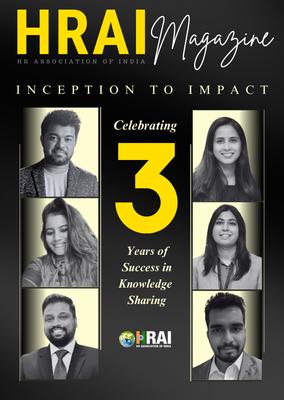





HRAI firmly believes in the power of teamwork and the value it brings. When diverse talents and perspectives come together, something extraordinary happens. The collective synergy we create goes beyond what any individual can achieve alone and together we see the potential to make a lasting impact on the world.
In every boardroom, break room, and brainstorm, women are reshaping the way the corporate world thinks, leads, and grows. This edition of our magazine, Empowering Women at the Workplace, is a celebration of that shift a tribute to the journeys, resilience, and contributions of women across industries.
Beyond celebrating achievements, we dive into the aspirations that fuel progress and the systemic changes still needed to create truly inclusive workplaces Through powerful stories, expert insights, and practical strategies, this edition invites reflection, conversation, and most importantly, action
Because empowering women isn’t a box to check it’s a mindset, a culture, and a commitment we must carry forward every single day.
Happy reading!

Empowering Women in the Workplace: The Role of AI and Inclusive Policies

Breaking Barriers, Building Futures: The Path to True Workplace Gender Equality

Empowering Women in the Workplace Breaking Barriers, Unlocking Potential

Empowering Women in the Workplace: A Path to Equality and Success

Empowered Women, Empowered Future: Leading he AI Revolution with nclusion



Diversity without respect is tokenism Equity without empowerment is hollow. Inclusion without autonomy is control in disguise. he belonging ueprint: Creating uly inclusive orkplaces

Empowering Women in the Workplace: A Call to Action for a More Equitable Future

Empowerment Is a Ripple Effect: How One Action Creates Waves of Change

ng Women in lace: From to True
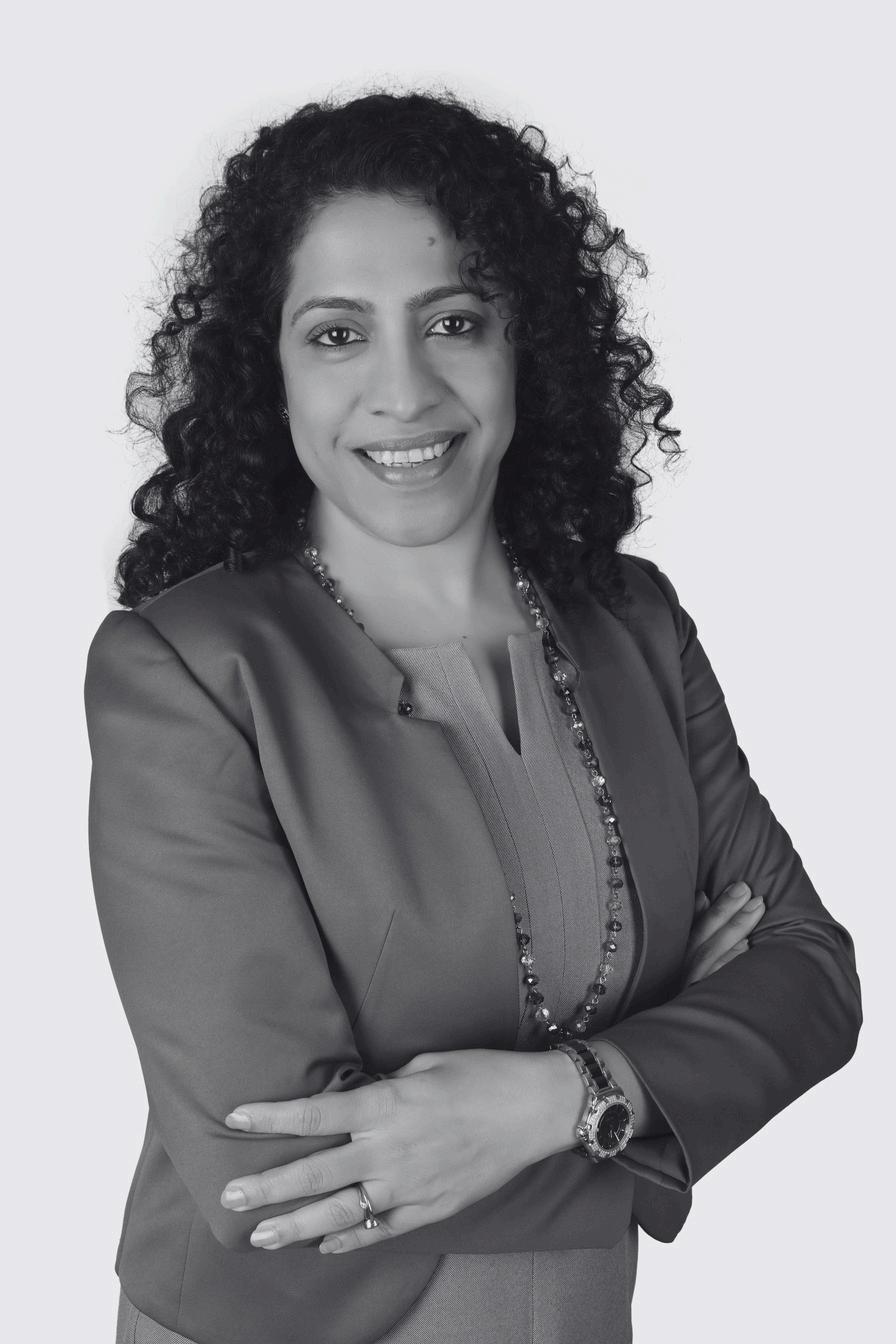

Empowering Women

Empowering Women in

Empowering Women in


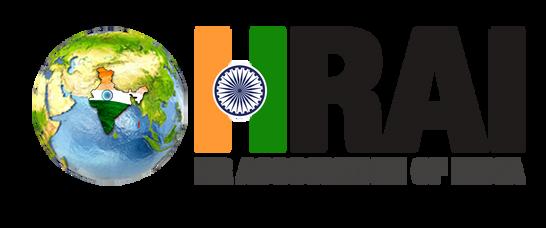
e HR Association of India (HRAI), founded in 2020 is an esteemed non-profit organization that has been playing a pivotal role in shaping the HR landscape in India. Their primary focus is on exploring, discussing, and promoting the latest business scenarios, market trends, change management, and leadership in the HR industry. HRAI is dedicated to creating a community of professionals, learners, and mentors who share their insights and learn from each other to elevate the standard of HR practices in the country

HRAI's success is attributed to its commitment to excellence and tireless efforts in facilitating interactions between HR professionals and subject matter experts. Through its initiatives such as panel discussions, masterclasses, one-on-one talk shows, and Q&A sessions with thought leaders, HRAI provides a platform for professionals to gain in-depth knowledge and practical solutions that can be applied in real-time.
In addition to their educational initiatives, HRAI also recognizes organizations' best practices and individual contributions through awards and conferences. These events celebrate the achievements of exceptional professionals and organizations that have made significant contributions to the HR industry in India. Over the years, HRAI has featured more than 1,000 experts and leading minds in the fields of HR, IT, Marketing, Finance, and more, making it a hub for learning and networking.
For HR professionals in India, HRAI offers unparalleled opportunities to connect with like-minded peers, learn from experts, and gain recognition for their hard work and achievements By joining HRAI, HR professionals can stay updated on the latest trends, best practices, and strategies that can help them take their careers to the next level.
HRAI, founded by Dr. Ankita Singh, drives industry initiatives and organizes prestigious awards for organizations, emerging leaders, and trailblazing women leaders Notable participants include Hindustan Unilever, Birlasoft, Biocon, Lenovo, IHG Hotels, Volvo and more..
Our commitment to excellence is reinforced through partnerships with the Great Managers Institute and top 100 great managers, who have taken masterclasses and featured in Forbes Magazine.
Elite leaders like Dr. TV Rao, Harjeet Khanduja, and Prasenjit Bhattacharya have graced our one-on-one talk shows, enhancing our members' knowledge base.
Our article initiative showcases thought-provoking articles by eminent leaders from organizations like BCCL, EY, Max Life Insurance, SAP, Kotak life, Bajaj Energy, TimesPro, Jio, Welspun Group, Great place to work and Accolite Digital.
The 23 Of 2023 and 24 of 2024 Initiative recognized exceptional leaders and entrepreneurs based on a predetermined theme. Featured leaders include those from organizations Eros Now, Adani Group, Future Generali, Yes Securities, Timezone, Dabur, Yatra, JSW, KPMG Global Services and more. The list also featured notable public figures/Sharktank Jury: Ghazal Alagh, Ritesh Agarwal, Deepinder Goyal and Amit Jain:

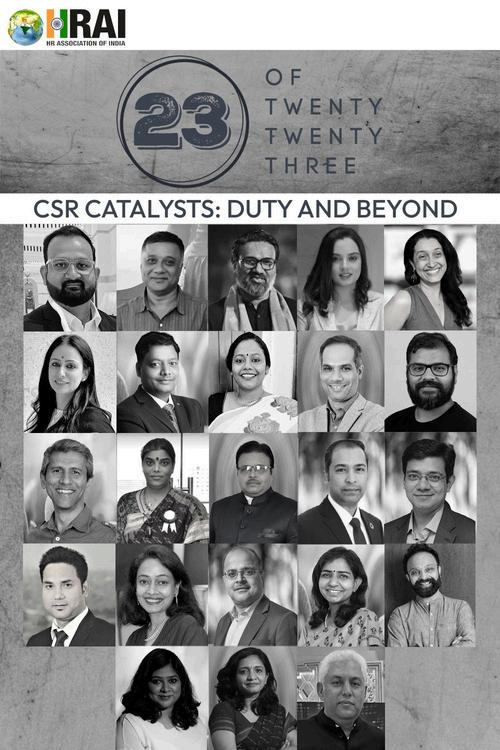












Women’s empowerment in the workplace is a critical driver of economic growth, innovation, and social progress. While advancements have been made in gender equality, many challenges remain, including workplace biases, the gender pay gap, and barriers to career advancement. However, Artificial Intelligence (AI) and digital transformation are proving to be game-changers in promoting inclusivity and leveling the playing field. By integrating AI-driven solutions, organizations can create fairer workplaces, enhance professional development, and support a better work-life balance for women
AI as a Catalyst for Women’s Empowerment
1. AI in Hiring and Talent Development
AI-powered recruitment tools are reducing bias by focusing on skills and qualifications rather than gender. Traditional hiring processes often suffer from unconscious bias, which can lead to women being overlooked for key roles. AI-driven applicant tracking systems, such as HireVue and Pymetrics, analyze candidates based on objective data, minimizing human bias. Research shows that companies using AI in hiring have reported a 25% increase in diversity among shortlisted candidates.
Furthermore, AI-based learning platforms like Coursera and LinkedIn Learning provide flexible and personalized training programs, enabling women to upskill in high-demand fields such as data science, AI, and leadership These platforms allow women to learn at
PROFESSIONAL DEVELOPMENT, AND SUPPORT A BETTER WORKLIFE BALANCE FOR WOMEN.


their own pace while managing family responsibilities, thereby improving their career prospects
Despite women comprising nearly 50% of the global workforce, they hold only about 28% of senior leadership roles AI-powered leadership development programs are addressing this gap by offering personalized career coaching, skills assessments, and mentorship matching. For example, AI-driven platforms like BetterUp use behavioral science and AI analytics to provide targeted executive coaching, helping women navigate career growth challenges
Balancing professional and personal responsibilities remains one of the biggest challenges for working women. AI-powered automation tools are helping women manage their workloads efficiently Virtual assistants like Microsoft Copilot and Google Assistant automate repetitive administrative tasks, freeing up time for strategic work and personal commitments.
Women still bear a disproportionate share of caregiving responsibilities. AI-driven smart home devices, such as AI-powered nanny cams and voice-assisted scheduling, help manage household tasks more efficiently Platforms like Kinside, an AIpowered childcare marketplace, assist working mothers in finding reliable childcare services, reducing the stress of balancing work and family life.
Workplace stress and burnout affect many professional women, particularly those
in leadership roles. AI-powered mental health apps like Woebot and Wysa offer round-the-clock emotional support, guided meditation, and cognitive behavioral therapy-based coaching A study by the World Economic Forum found that AI-driven mental health interventions have increased employee well-being and productivity by 20% in organizations that have adopted them
While AI presents tremendous opportunities for women ’ s empowerment, it also comes with challenges AI algorithms can reflect societal biases if not properly designed. Studies have shown that AI-driven hiring systems, if trained on biased data, may reinforce gender stereotypes. For example, Amazon’s AI hiring tool was found to disadvantage female applicants due to historical hiring data favoring men To mitigate this, organizations must prioritize ethical AI practices, such as transparency in algorithm development and bias audits
Additionally, women remain underrepresented in AI development teams, with only 22% of AI professionals being women, according to a UNESCO report Increasing female participation in AI research and development is crucial to ensuring that AI systems are designed to be inclusive and beneficial for all
PROFESSIONAL
PERSONAL
REMAINS ONE OF THE BIGGEST CHALLENGES FOR WORKING WOMEN.

Organizations and governments must implement policies that support women ’ s empowerment through AI-driven initiatives:
1
Flexible Work Arrangements –
Encouraging remote work and hybrid models helps women balance work and family responsibilities. Companies like Dell and Salesforce have implemented AI-powered flexible scheduling systems that allow employees to choose work hours that fit their lifestyles
2.
AI-Based Mentorship and Sponsorship Programs – AI-driven career mentorship platforms, such as MentorCloud, connect women with industry leaders, providing guidance for career advancement.
workforce, driving innovation and sustainable growth.

AI Bias Audits – Regular evaluations of AI algorithms to ensure gender-neutral decision-making in hiring, promotions, and performance assessments
3 Investment in Women- Led AI Initiatives – Supporting women entrepreneurs and researchers in AI ensures diverse perspectives in technology development 4.
Conclusion
Empowering women in the workplace is not just a moral imperative but a strategic necessity for organizations aiming for longterm success AI and digital transformation provide powerful tools to bridge gender gaps in hiring, leadership, and work-life balance. However, ethical implementation and inclusive policies are essential to ensure AI benefits all employees fairly By fostering an AI-driven workplace that prioritizes gender equality, companies can unlock the full potential of their female
Abhinav Sharma is a seasoned AI and Automation leader with over 22 years of experience in developing production-grade SaaS products, utilizing AI/ML, Deep Learning, and Cloud technologies. As the Chief Technology Officer (CTO) and Director of AI & Automation for Customer Experience (CX) in the Asia Pacific, Japan, and China (APJC) region at Cisco Systems, he has been pivotal in driving AI innovation and enhancing IT operations. Abhinav led the development of Cisco's flagship Unified Enterprise Automation Platform (CNAAP), leveraging AI to streamline operations and improve customer experiences. Before joining Cisco in April 2021, he held significant positions, including Vice President and Head of Cloud Engineering & Customer Success at HCL Technologies from 2010 to 2020, and Senior Technical Platform Manager at Infosys Technologies from 2006 to 2010.
Abhinav's leadership has earned him recognition as one of the Top 200 Global Leaders in Technology and among the Top CTOs in India for 2023 and 2024. He holds a Bachelor of Technology in Mechanical Engineering from Aligarh Muslim University, a Master of Business Administration in Information Systems Management from the Indian Institute of Technology Delhi, and a Postgraduate Diploma in Artificial Intelligence and Machine Learning from BITS Pilani. Passionate about AI and automation, Abhinav continues to influence the industry through his strategic vision and commitment to technological advancement.



Achieving gender equality in the workplace goes beyond simply balancing workforce demographics; it requires fostering an environment where every individual regardless of gender has equal opportunities to thrive, contribute, and lead While progress has been made, true equity means eliminating systemic barriers that prevent talent from reaching its full potential This vision demands a fundamental shift in workplace culture, policies, and leadership approaches.
Creating an inclusive workplace begins with recruitment strategies that actively remove biases from the hiring process. Gender-neutral job descriptions, diverse hiring panels, and objective assessment methods help ensure that roles appeal to all qualified candidates, avoiding language that may unintentionally deter certain groups from applying.
By broadening candidate pools and focusing on skills and potential, organizations can create fairer hiring processes Highlighting career growth opportunities and mentorship programs further attracts diverse talent. Collaborations with educational institutions can also bridge gender gaps, fostering an inclusive hiring environment from the outset.


CLEAR, MERIT-BASED CRITERIA FOR PROMOTIONS, BONUSES, AND SALARY INCREMENTS ENSURE THAT COMPENSATION DECISIONS REFLECT SKILLS AND CONTRIBUTIONS RATHER THAN NEGOTIATION PROWESS, WHICH CAN SOMETIMES DISADVANTAGE WOMEN.


At The Times of India Group, structured hiring practices have reinforced a culture of meritocracy, fostering equitable career growth opportunities for all employees.
A truly equitable workplace ensures diverse representation at all levels, particularly in leadership roles Organizations must actively develop inclusive leadership pipelines through targeted development programs, sponsorship initiatives, and succession planning that prioritizes diversity
For instance, The Times of India Group has successfully cultivated a pipeline of women leaders through structured leadership programs, leading to a more balanced representation across departments. Such initiatives demonstrate how deliberate interventions can close leadership gaps and drive inclusivity.
Closing the gender pay gap requires more than good intentions; it necessitates rigorous pay audits and the implementation of transparent compensation frameworks Clear, merit-based criteria for promotions, bonuses, and salary increments ensure that compensation decisions reflect skills and contributions rather than negotiation prowess, which can sometimes disadvantage women.
Organizations that adopt standardized pay scales and structured evaluation mechanisms foster an environment where equal pay for equal work is a reality rather than an aspiration Pay transparency builds trust and reinforces a culture of fairness.
Unconscious biases often creep into promotion decisions, undermining efforts toward gender equality. To counteract this, organizations should establish structured, competency-based hiring and promotion processes that minimize subjectivity and promote fairness
Workplace Flexibility Without Career Penalties
Flexible work arrangements play a critical role in supporting employees’ ability to balance professional and personal responsibilities without jeopardizing career growth. Hybrid work models, part-time leadership roles, and job-sharing options should be normalized to prevent career stagnation due to caregiving responsibilities
The Times of India Group has demonstrated that flexible work policies can enhance productivity while allowing employees to manage caregiving duties effectively By institutionalizing such policies, organizations can create an environment where work-life balance and high performance coexist


Creating a gender-equal workplace requires more than policies it demands a culture of inclusion where diverse perspectives are valued and celebrated. Employee resource groups (ERGs) dedicated to gender inclusion can provide mentorship, networking opportunities, and support systems for underrepresented talent.
Leadership plays a vital role in shaping an inclusive culture by addressing microaggressions, fostering open dialogue, and ensuring equitable participation in decision-making A workplace where employees feel heard and valued is one where true equality can flourish.
Despite progress, gender imbalances persist in certain industries and roles. Organizations must actively dismantle stereotypes and support diverse career choices by offering exposure, mentorship, and skill-building programs from an early stage.
Internships, structured career guidance, and targeted development initiatives empower individuals to pursue their aspirations free from societal constraints, ultimately leading to a more diverse workforce
Parental leave policies play a crucial role in fostering gender equality by encouraging shared caregiving responsibilities. When both parents have access to adequate
leave, traditional caregiving roles shift, reducing the disproportionate burden often placed on women
On-site childcare facilities, lactation rooms, and caregiver support initiatives further enable employees to integrate work and family life seamlessly Encouraging all caregivers to participate actively in family responsibilities helps create an equitable culture, benefiting both employees and organizations.
A truly gender-equal workplace is one where employees feel safe, respected, and empowered to speak up. Organizations must implement robust anti-harassment policies, confidential reporting mechanisms, and regular sensitization training to foster a culture of accountability
A zero-tolerance stance on harassment, coupled with proactive interventions, ensures that employees can work in an environment free from fear and discrimination Organizations that prioritize respect and safety build workplaces where employees can perform at their best without hesitation
Leadership commitment is the cornerstone of embedding gender equality into an organization’s culture. Executives must champion inclusive policies, hold managers accountable for diversity initiatives, and ensure that gender equality remains a strategic priority An inclusive culture begins with leadership actions whether by fostering open


dialogue, addressing biases, or advocating for equitable practices. Leaders who prioritize gender balance inspire teams to embrace inclusivity, driving meaningful and sustained change
What gets measured gets managed Organizations must track key gender diversity metrics, including representation at different levels, pay parity, and retention rates. Regular reporting fosters transparency and accountability, ensuring continuous improvement in gender equality efforts
By embedding gender diversity goals into performance evaluations and organizational KPIs, businesses can integrate gender equality as a core strategic priority rather than an afterthought.
Achieving gender equality is not solely the responsibility of women all employees must actively contribute to fostering an inclusive workplace. Camaraderie training, awareness programs, and mentorship initiatives encourage a collaborative approach to gender equity. When employees at all levels challenge biases, advocate for fair policies, and support diverse talent, organizations move closer to true inclusivity. Actively engaging employees in gender equity initiatives ensures that progress is not merely policydriven but deeply embedded in workplace culture
A truly equitable workplace is one where individuals are valued for their contributions and potential without bias or limitations In
ACHIEVING GENDER EQUALITY IS NOT SOLELY THE RESPONSIBILITY OF WOMEN ALL EMPLOYEES MUST ACTIVELY CONTRIBUTE TO FOSTERING AN INCLUSIVE WORKPLACE.
such an environment, people grow, lead, and succeed based on merit rather than outdated norms.
Achieving gender equality requires collective effort, introspection, and sustained commitment. By driving systemic reforms, fostering inclusivity, and ensuring leadership accountability, organizations can transform gender equality from an aspiration into a reality.
Companies that embrace gender parity not only build fairer workplaces but also unlock their workforce’s full potential fuelling innovation, collaboration, and long-term success.
Amit Das is the Director-HR & CHRO at The Times of India Group, where he leads Human Capital function for one of India’s most influential media conglomerate. With over 36 years of experience across reputed organizations such as Britannia Industries, Vodafone, RPG Group, CESC Ltd., and Taj Group of Hotels, he has led large-scale organizational transformation initiatives and seamlessly integrated HR with business strategy to drive sustainable growth across diverse industries. Beyond the corporate world, Amit has played strategic Advisory roles with Government institutions and contributes actively to leading Academic Institutions as a thought leader and industry mentor
COLUMN BY CA ABHAY MAHESHWARI
These aren’t just clever words-they’re a reality many women live every day, especially when it comes to managing money Empowering women in the workplace must go beyond policies and programs It must include helping them take charge of their financial lives
Recently, I received a call from a 49year-old widow-a qualified teacher, mother to an 11-year-old boy, and caregiver to her 80-year-old mother Her husband had passed away during the COVID-19 pandemic He handled all financial matters, and she had never bothered to ask questions Now, with no monthly withdrawal coming in, her mutual fund advisor unreachable, and no knowledge of what or where their investments were, she was in crisis
It took her over three years to just identify the family's assets and claim her rights. By then, much damage had been done-poorly chosen investments with long lock-ins, insurance agents exploiting her, and family members-both in-laws and her own-taking advantage of her vulnerability. Despite her education and professional skills, she

ABOUT ABHAY:
had never truly prioritized her career or finances This isn’t a one-off case It's a pattern
History tells a different story In precolonial India, women held strong economic agency They owned wealth and were respected for their financial wisdom Women in India were empowered and had liberties that often get ignored in modern narratives The fact that the deity of wealth-Lakshmi-is a Goddess, is beyond symbolism
Colonial influences and imported frameworks have ironically distanced us from that indigenous strength Today’s workplace DEI (Diversity, Equity, Inclusion) efforts often follow Western templates-checkboxes without context Reflecting on our cultural roots, which once celebrated feminine autonomy, is likely to provide us with much more confidence & inspiration, and better solutions as opposed to copy-pasting from societies where women had to wait 100+ years even after independence to just get voting rights. However, we are yet to tread that path.
CAAbhay Maheshwari, Founder & CEO of ASM Wealth, is a Chartered Accountant and MBA from Indiana University in the US. He has over a decade of experience in the IT & Financial Services Sector and international experience having worked in the Private Equity space in Singapore Abhay has been an active investor since his teenage years and already seen 2 full market cycles Along with his team, he manages over 150 crore in investments across Mutual
MAHESHWARI

The workplace is a powerful environment to fast forward this journey. HR professionals can be the torchbearers of real empowerment. By encouraging financial literacy, offering support systems for freshers, widows & single mothers, and building spaces where women are not afraid to talk about money, we can begin to restore that autonomy. Workshops on investment basics, access to trusted advisors, and mentorship programs around financial independence can all be part of a progressive HR agenda
It’s not about asking women to do it alone It’s about ensuring that support systems exist to prevent exploitation and enable informed choices
Empowered women at work are not just productive-they’re resilient, confident, and inspiring They make better leaders, better mentors, and stronger contributors to society in professional & personal roles But this journey starts with the simple act of awareness-of knowing where their money is, what it’s doing, and how it can serve them
As professionals, let us make space not just for women at the table, but for women who know what the table is worth
Funds and Direct Equities Abhay's goal is to empower people by teaching them about personal finance so that they can choose the right strategies & advisors, while not getting carried away by false promises, narratives and misselling Abhay can be reached at 9892696758/9987675877 | Abhay asmwealth@gmail com





In a world increasingly shaped by artificial intelligence, the conversation around leadership is evolving. But while algorithms may be reshaping workflows and automation is redefining roles, one constant remains: empowered women are essential to a thriving, forwardlooking corporate culture. As we stand at the intersection of technological revolution and gender equity, it’s time to place women at the center of the AI narrative not as bystanders, but as leaders, creators, and catalysts for change.
The Current Landscape: A Gender Divide That Demands Change
Despite decades of advocacy, women continue to face underrepresentation in both corporate leadership and AI-driven roles. According to the World Economic Forum's 2024 Global Gender Gap Report, women make up just 26% of data and AI roles globally Meanwhile, McKinsey's "Women in the Workplace 2023" report notes that only 28% of C-suite positions are occupied by women.
These disparities are more than just numbers they represent missed opportunities for innovation, ethical oversight, and inclusive progress When women are excluded from AI development and leadership spaces, the result is biased systems and policies that fail to consider the needs of half the population True empowerment lies in not just giving women a seat at the


WE MUST ADDRESS THE CHALLENGES FACED BY EMPLOYEES FROM DIVERSE SOCIOECONOMIC BACKGROUNDS, ENSURING THEY FEEL VALUED AND DON'T FEEL PRESSURED TO CONFORM.


table, but allowing them to shape the very structure of that table.
While AI has the potential to deepen inequalities if unchecked, it also offers transformative tools to uplift women. From AI-driven mentoring platforms to machine learning algorithms that reduce bias in hiring, technology can help create fairer, more transparent workplaces.
Companies like Unilever and Accenture are already using AI to anonymize resumes, helping ensure that women receive equal opportunities based on merit. AI can also identify wage gaps, support inclusive performance reviews, and enable flexible work arrangements that support work-life balance a key factor in retaining women in leadership pipelines.
Yet empowerment requires more than tools. It requires intention. And it starts with ensuring that women are not only users of AI but leaders in building and governing it.
Across the globe, woen are stepping into powerful roles, redefining what leadership looks like in the AI space Leaders like Joy Buolamwini, founder of the Algorithmic Justice League, have been instrumental in exposing racial and gender bias in facial recognition technology, influencing tech firms to rethink their AI strategies
Such trailblazers demonstrate the critical need for female perspectives in shaping AI that is just, ethical, and inclusive. Women bring strengths in empathy, collaboration, and long-term thinking qualities that are increasingly recognized as essential to responsible tech leadership.
Women don’t need to adapt to outdated leadership models they need to redefine them Inclusive leadership means embracing emotional intelligence, championing diversity, and being unafraid to challenge the status quo These aren’t "soft" skills they’re power skills.
Empowerment comes from visibility, sponsorship, and access. Programs like Google’s Women Techmakers, IBM’s AI Skills Academy, and Meta’s Women in AI initiative are equipping women with the tools and networks they need to excel in AI-powered industries
Corporate policies must also reflect this commitment From gender-neutral hiring processes to leadership training designed for women, organizations must take a proactive stance. It’s not enough to talk about empowerment it must be woven into the DNA of the company
Women empowerment is not about adding diversity for optics; it's about creating a culture where women thrive, lead, and influence. It requires:
Mentorship and sponsorship: Women need champions in the boardroom who advocate for their growth
Transparent policies: Equal pay audits, unbiased performance reviews, and clear promotion criteria help level the field.
Technology allows for greater flexibility something that particularly supports working mothers
Representation at the top: Women must see themselves in leadership roles to aspire and believe.


According to Deloitte, companies with inclusive cultures are six times more likely to be innovative and twice as likely to meet or exceed financial targets. Empowering women isn’t just the right thing it’s the smart thing.
AI presents an extraordinary opportunity for women to reclaim power in shaping the future of work. But empowerment must be intentional. It must start from the classroom, continue in the boardroom, and be embedded in the algorithms that will soon govern our daily lives
Leadership in the AI age must evolve from exclusivity to inclusivity, from authority to authenticity. Empowered women can and must be at the heart of this evolution It’s time we make the path clearer by creating environments where women are heard, elevated, and celebrated not just in words, but in practice.
Dr. Ankita Singh, Chief People Officer with 22+ years of experience, has led impactful HR transformations, especially in the dynamic ITES sector At CIGNEX Datamatics, her strategic initiatives fostered a performance-driven culture, earning the company multiple “Great Place to Work” certifications Honored as “Woman Leader of the Year” by TOI and named among Forbes India’s “Top 100 Managers,” she is widely respected for her progressive approach.
Ankita holds an MBA in HR+IT, an Executive MBA, and a Ph D in Management Known for her sharp business acumen and people-first mindset, she continues to shape inclusive, highperforming workplaces that inspire growth and innovation
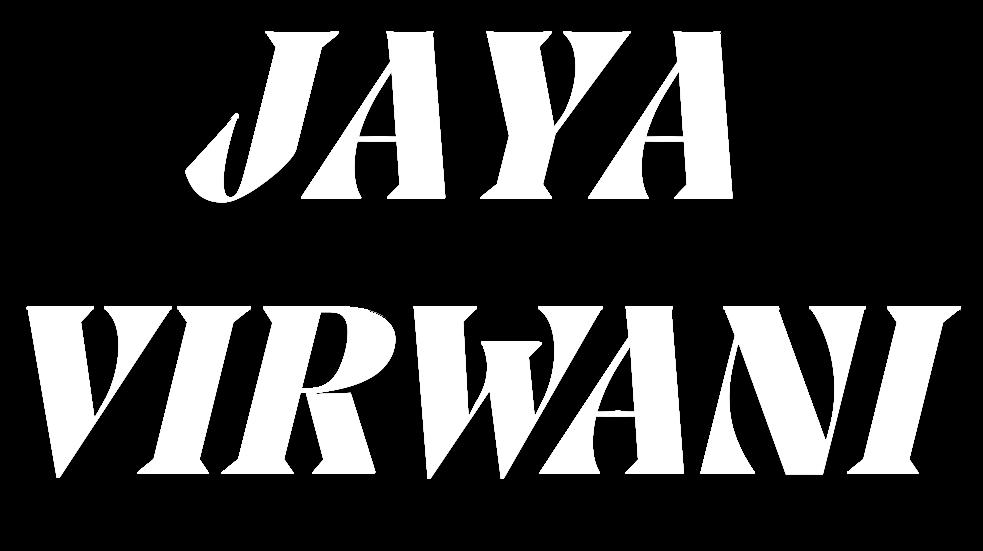


The landscape of work has been undeniably transformed by women, yet the pursuit of true gender parity remains slow. According to the Global Gender Gap study conducted by the World Economic Forum 2024, India ranks 129 out of 146 countries in gender pay parity, with an index score of 0.641 (The index ranges from 0-1,1 indicating parity)
What contributes to the underlying gap? A study by McKinsey on the American workforce reveals some of the underlying causes, such as spending lesser time on the job compared to men, having to take longer career breaks, occupying more part time roles from men, taking up lower paying jobs – a lot of which can be attributed to gendered expectations from life and personal matters If such is the case, is the workplace of today equipped to truly foster Inclusion for All?
Creating a culture of belonging and innovation
It is important to understand that while inclusiveness can be behaviour-centric, workplaces must a) cultivate systemic enablers that set everyone up for success, across levels and b) build an environment that factors in diverse lives and experiences and accommodates them It is only through this change can we build ecosystems that enable psychological safety and a sense of belonging. This requires leaders to effectively implement inclusive policies, address negative behaviours, and nurture supportive team environments EY’s DE&I Business Impact Research Report 2023 clearly explains t


WE MUST ADDRESS THE CHALLENGES FACED BY EMPLOYEES FROM DIVERSE SOCIOECONOMIC BACKGROUNDS, ENSURING THEY FEEL VALUED AND DON'T FEEL PRESSURED TO CONFORM.


his linkage: a stronger sense of belonging correlates to +3 points higher retention among teams
Beyond retention and higher profit margins, it's about creating workplaces where everyone thrives, regardless of background. We must address the challenges faced by employees from diverse socio-economic backgrounds, ensuring they feel valued and don't feel pressured to conform. Organizations should aim to build a harmonious, creative, and ultimately successful organization where everyone feels they belong
systemic barriers
From a leadership standpoint, there is no better time than now, to advance inclusiveness across the board At GDS, this is clearly reflected through the tone from the top: we ’ re moving beyond surface-level gestures, embracing a bold, actionoriented approach to dismantle the systemic barriers holding women back We're not just acknowledging biases; we ' re actively dismantling them, ensuring every woman has equitable access to opportunities. I have witnessed our diversity efforts evolving into powerful engines of change, fuelled by clear accountability and measurable results Our leaders are building a future where true equity thrives, and the organization flourishes as a result
To drive a culture of inclusiveness and equity for all, GDS runs several programs, such as:
·Sponsorship for career advancement: Senior leaders are required to sponsor at least one woman to understand their aspirations, set career goals, and support their growth. The revamped program includes new milestones and preparation
for panel interviews. The aim of this program is to introduce systemic enablers that aid diverse communities to rise through the ranks, encouraging diversity at the leadership level
Leadership pipeline: We have targets for women in leadership pipelines, ensuring equal pay for equal work and correcting disparities for new hires and existing employees. Annually, we assess the performance and potential of women at senior levels to identify and nurture highpotential candidates for leadership roles. Year-end reviews ensure women ' s promotions are proportional to gender diversity at that level, maintaining gender parity across ranks.
Learning and upskilling: To encourage non-partisan decisions, we offer programs, especially for decision makers (recruiters, leadership, managers etc.), like Inclusive Leadership for All, team workshops, nonconscious bias sessions, and rank-based initiatives focused on the professional development of women We also proactively identify programs and awareness sessions based on employee feedback and our goal to be the best-inmarket, helping our diverse population feel like they belong
Wellness is a priority, with an approach towards flexibility and inclusivity in our policies and programs Our benefits programs cater to diverse definitions of family, and our liberal leave and parental policies remain gender agnostic, factoring in domestic partner relationships and LGBTQ+ families We promote a best-inclass experience through sponsorship via a wellness council and purpose groups that


pursue this agenda
Social equity taskforce and uplift social equity: Since launching our global taskforce in 2020, we have introduced the Uplift Social Equity storytelling campaign and provided training for business teams to keep employees at the forefront of equity conversations Our "All in Moment" guide promotes inclusive team practices, ensuring every voice is heard
Careers for women in the community: ReWrite is our second careers program which supports women returning to the workforce after a career break, challenging the stigma associated with career gaps. Externally, we also have RISE, a program that offers a 4week learning program and 12-week internship designed to create sustainable careers and focus on equitable opportunities for diverse socio-economic backgrounds.
Building a support system
While Programs and policies facilitate personal journeys, real change can only be driven by promoting a sense of community and connection This is where our Sunshine clubs, enabling employees to live out their purpose and passion, and our community engagement groups for allies of diverse communities in GDS, come into play. These communities promote open discussions on sensitive topics like fertility struggles, adoption, surrogacy, and menopause, intersectionality between families and other themes like disability, social equity and mental health These conversations drive a supportive environment that respects diversity and accommodates cultural specificities
Through webinars, counselling, workshops, and sensitization programs, our networks strive to enhance employee experiences and
relationships, making the workspace feel like a second home. It aims to break traditional norms, promote open dialogue, and support employees in defining their own concept of family
As leaders, we must recognize that achieving true gender parity requires more than just policies; it demands a cultural shift Our commitment to inclusion for all, is evident through structured programs that support women in their career journeys By prioritizing wellness, flexible working models, and modelling transformative and inclusive leadership behaviours, we create an environment where every employee feels valued and empowered. Initiatives that promote open dialogue on sensitive topics ensure a supportive and diverse workplace Together, we can dismantle systemic barriers, drive innovation, and build a future where equity thrives, benefiting both our employees and our organization. Let us continue to lead with purpose, accountability, and measurable results, making gender parity a reality.
Jaya Virwani is the Global DEI Leader for EY Global Delivery Services (GDS). She has been with the firm since June 2004 assuming the role of Diversity, Equity and Inclusiveness leader in March of 2012, and the Ethics leader role in February 2018. In her role as DE&I leader, she focuses on initiatives that promote cross-cultural teaming and inclusive leadership, mitigate unconscious biases, and create an ecosystem that supports gender equity in senior leadership positions She previously headed the Ethics office and was responsible for driving consistent behavior of the highest ethical standards across EY Global Delivery Services.




Workplace of today has undergone substantial transformations in recent years, with one of the major changes being the rapidly increasing number of women in the workforce While, many large organizations are making focused efforts in this direction and significant progress has been made so far, women still face numerous challenges and hurdles that hinder their ability to reach their full potential. Empowering women at the workplace is critical and essential for creating a more inclusive, effective, diverse, and productive work environment.
Women are nearly half of the global population and workforce, yet they remain highly under-represented in leadership positions and face persistent pay gaps at all levels. As per a study done by McKinsey, women hold only about 1/5 of executive and senior-level positions, and the pay gap between the two genders is more than 15% globally Such disparities are not just unfair and unethical but also detrimental to businesses, as it results in the loss of valuable talent, skills, and diverse perspectives
Let’s look at the factors preventing women from achieving their full potential in the workplace, some of which are listed below:
1. Pay gap: This has been a persistent issue where pay


THEM AND CREATE A MORE INCLUSIVE AND SUPPORTIVE WORK ENVIRONMENT.


gap between men and women has existed for decades in the modern world, leading to women earning less than males for similar work.
2. Bias and Stereotypes: Hidden and unconscious biases and stereotypes often impact hiring decisions, work assignment, performance evaluations, and promotions In many organisations, this leads to women being perceived as less capable or less committed to their careers, just because of their gender.
3. Flexibility at workplace: Many organisations still follow traditional, age old arrangements at workplace, which are inflexible making it difficult to maintain work life balance, making it even more difficult for women to balance work and family responsibilities.
4. Sexual Harassment and Bullying:
Women may face sexual harassment and bullying at the workplace, much more than men, which may lead to creation of a hostile and intimidating environment preventing them from working
5. Lack of Mentorship and Sponsorship:
To bridge the divide between men and women at workplace, women need to be provided mentorship and sponsorship, while they often lack access to such opportunities. If proper mentoring and sponsorship are available, it can help women navigate the workplace and advance their careers in a much better way.
for Empowerment
Organizations need to implement focused strategies to empower women in workplace, address the barriers barring them and create a more inclusive and supportive work environment Along with various strategies, voice from the top makes a lot of difference in terms of driving the
culture in any organization and that ensures to what extent such strategies would be successful Some effective strategies include:
1. Flexible Work Options: Organizations offering hybrid / flexible work options, such as telecommuting, flexible hours, job sharing, etc. to help women balance work and family responsibilities are preferred over those not offering these options.
2. Zero-Tolerance Policy for Harassment:
Organizations need to have a strict, zerotolerance policy for sexual harassment and bullying, and provide a safe and confidential reporting mechanism for incidents
3. Diversity and Inclusion Training:
Training programs raising awareness about bias, stereotypes, and the importance of diversity and inclusion go a long way in promoting diversity, equity and inclusion
4. Mentorship and Sponsorship Programs: Mentorship and sponsorship programs connecting women with senior leaders and providing opportunities for networking and career development can help retain women workforce and help them move up the ladder.
5. Pay Equity Analysis: Conduct regular pay equity analyses to identify and address pay disparities between men and women
Promoting gender diversity in the organizations by empowering women at the workplace is not only the right thing to do, but it also has numerous benefits for the organizations, like:
1. Increased Diversity and Innovation:
Women bring diverse perspectives and ideas to the workplace, leading to increased innovation and creativity and growth opportunities


1.
Employee Engagement and Retention: Empowering and supporting women at workplace will make them more engaged and committed to their work, reducing turnover and improving retention.
2. Enhanced Reputation and Brand: Organizations empowering women in the workplace and promoting gender diversity are seen as progressive and inclusive, enhancing their reputation and brand.
3. Better Decision-Making: Women's participation in decision-making processes brings different perspectives and ideas, leading to more informed, inclusive and effective decision-making.
4. Increased Profitability: Various studies show that companies with more women in leadership positions tend to perform comparatively better financially and have higher growth and profitability.
There are many organizations that have successfully empowered women in the workplace, achieving significant benefits and improvements Some examples include:
1. IBM has implemented a range of initiatives to support women in the workplace, including mentorship programs, flexible work arrangements, and diversity and inclusion training
2. Microsoft has established a women ' s leadership development program, which provides training, mentorship, and networking opportunities for women.
3 Schneider Electric has implemented a range of initiatives to support women in the workplace, including flexible work arrangements, mentorship programs, focussed actions promoting female hiring, dedicated training programs for women, diversity and inclusion training, etc.
While empowering women in the workplace is important, it comes with its own challenges Some of the common challenges that organizations face include:
1. Resistance to Change: Some employees may resist changes aimed at empowering women, such as flexible work arrangements or diversity and inclusion training
2. Limited Resources: Small and mediumsized enterprises may lack the resources to implement initiatives aimed at empowering women.
3. Cultural and Societal Barriers: Women may face cultural and societal barriers that prevent them from participating fully in the workforce, such as caregiving responsibilities or lack of access To concluded, Empowering women in the workplace boosts diversity, productivity, and innovation while fostering inclusive leadership and engagement. Their participation drives business growth, profitability, and social responsibility, benefiting both organizations and society.
Mayank Holani is a seasoned finance professional with over two decades professional experience across various Indian and Multinational corporations He holds a Chartered Accountant degree from The Institute of Chartered Accountants of India along with DISA, DipIFR, CPA and M Com Professionally, Mayank has had a notable career, particularly at Schneider Electric, where he has held various leadership positions before being elevated to the position of CFO at Schneider Electric Infrastructure Limited He was instrumental in driving the transformation of the company Prior to Schneider Electric, he worked with companies like Cairn India Limited, Chambal Fertilisers and Chemicals Limited and JK Tyres & Industries Limited Currently, he is working as CFO with Indian Synthetic Rubber Private Limited (A Joint Venture of IndianOil and TSRC Corporation, Taiwan) As CFO, he is responsible for overseeing the financial strategy and operations of the company, driving business growth and profitability. He is an avid speaker on finance and is well known face across industrial, professional and academic forums.
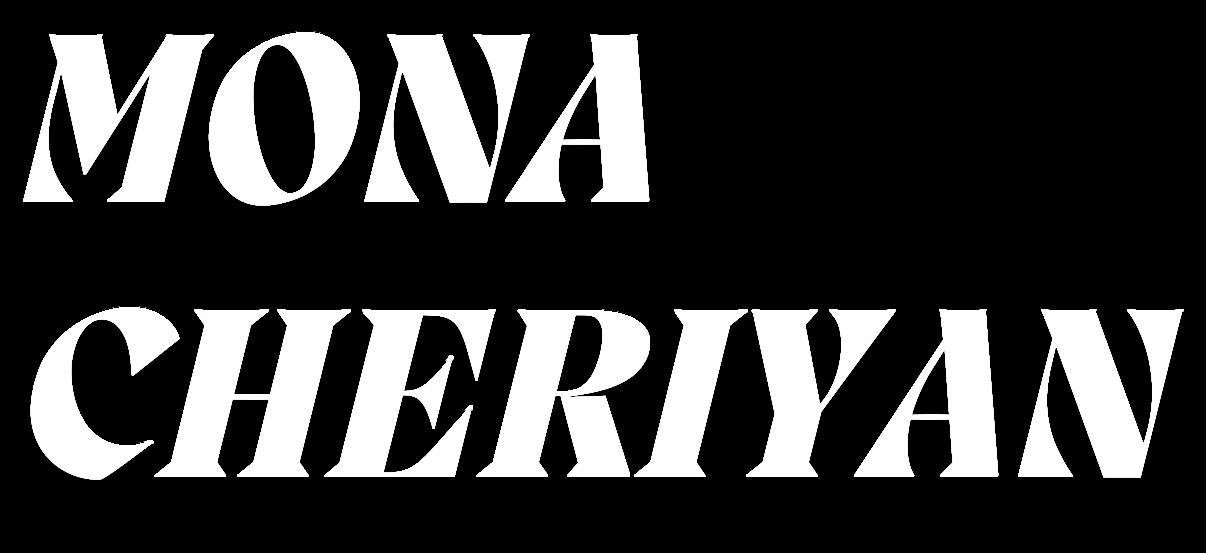



Nina had always been an ambitious professional. With a degree in finance and years of experience in investment banking, she was well-qualified for a senior leadership position However, each time a promotion opportunity arose, she was passed over in favor of her male colleagues. Despite excelling in her role, she was told she needed to be "more assertive" and "take up more space in meetings."
Frustrated but determined, Nina sought guidance and mentorship from a colleague who encouraged her to advocate for herself She started documenting her achievements, requesting feedback proactively, and positioning herself as a leader When a new promotion cycle arrived, she confidently presented her case, backed by data and testimonials from colleagues This time, the company recognized her contributions, and she became the first woman in a senior management role in her department
Nina’s story is a testament to the power of resilience and the importance of mentorship. It also underscores the need for organizations to recognize and address biases that hinder women’s advancement It is clearly a need for empowering women in the workplace.
In recent years, the conversation around Empowering Women in the Workplace has gained momentum. Organizations worldwide are recognizing that empowering women is not just a moral imperative but also a business necessity When women are given equal


ORGANIZATION S WORLDWIDE ARE RECOGNIZING THAT EMPOWERING WOMEN IS NOT JUST A MORAL IMPERATIVE BUT ALSO A BUSINESS NECESSITY.


opportunities, companies benefit from diverse perspectives, improved problemsolving, and increased profitability However, challenges persist, making it crucial to continue advocating for policies and cultural interventions that support female professionals.
Empowering women goes beyond hiring more female employees It involves creating an inclusive environment where women can thrive, lead, and contribute meaningfully. This means ensuring equal pay, providing leadership opportunities, fostering a culture of mentorship, and addressing unconscious bias.
A study by McKinsey & Company found that companies with gender-diverse executive teams are 25% more likely to outperform their peers financially. This statistic highlights the direct correlation between gender equity and corporate success. Yet, despite such findings, women remain underrepresented in leadership positions across industries.
The Thomas Cook Group has demonstrated a strong commitment to empowering women in the workplace through several initiatives. Women of Will (WOW) Initiative is a unique platform enables female employees to share their aspirations and challenges, fostering mutual support to achieve both professional and personal goals.
We have taken several DEI initiatives aimed at enhancing employee morale and strengthen the workforce, contributing to long-term financial gains. The Company has been honored as one of the Top 100 Best Companies for Women in India, reflecting its dedication to improving
gender diversity. We offer travel products which allow for single women to travel with like minded women on specially designed holidays. We support and prioritize partnerships with female-owned or operated tour groups, accommodations, and activities, promoting women ' s roles in the travel industry
This year we are offering a MDP (Management Development Programme) for our female employees which will be focused on skill and competency development for our female employees. We believe that a specific programme for our female employees will help them develop as leaders and also help them build a network of colleagues who will support their development journey in the organization
Our initiatives go beyond focusing on women only. We believe that to have an inclusive and safe environment, it is important to have a gender-neutral culture Our “Allyship” programme helps all genders address biases in the workplace and sensitizes employees on their role in promoting a gender-neutral culture.
EMPOWERING WOMEN GOES BEYOND HIRING MORE FEMALE EMPLOYEES. IT INVOLVES CREATING AN INCLUSIVE ENVIRONMENT


Empowering women in the workplace is not just about gender equality it is about unlocking the full potential of businesses and economies. While progress has been made, there is still work to be done By addressing biases, promoting equal opportunities, and fostering supportive workplace cultures, organizations can pave the way for a more equitable and successful future Every company and individual have a role to play in this journey. Whether through mentorship, advocacy, or policy changes, taking action today will create a better, more inclusive tomorrow for all "When women break barriers in the workplace, they don’t just open doors for themselves they leave them open for others to follow." – Michelle Obama
Mona Cheriyan, President and Group Head of Human Resources at Thomas Cook India Ltd., brings nearly 40 years of HR expertise across diverse industries. She is responsible for developing and executing human resource strategies that align with the organization's business objectives. Mona actively mentors women in corporate India and lectures at institutions like TISS and SP Jain. She has held leadership roles in NHRD and BMA, driving initiatives in diversity and inclusion Her accolades include the "Most Influential HR Leader" award and the "Indira Women Achievers Award 2024 " Under her leadership, Thomas Cook's Centre of Learning has achieved significant growth in skill development and employment generation for the travel and tourism sector




"There is no limit to what we, as women, can accomplish " – Michelle Obama
As we applaud another International Women's Day, it is both a moment of celebration and reflection. We celebrate the significant progress that women have achieved in the workplace, but we recognize that the path to genuine equality is still a WIP. The halls of corporate authority, which were once filled with similar viewpoints, now vibrate with the diverse insights that women contribute. However, in numerous boardrooms, an evident glass ceiling continues to persist
Empowering women in the workplace is not just an ethical obligation; it is also a strategic necessity. It is essential for creating resilient, innovative, and successful organizations. Throughout my corporate experiences, I have witnessed that when women succeed, companies also prosper In many instances, women excel as decision-makers vis-à-vis their counterparts.
The World Economic Forum's Global Gender Gap Report consistently highlights those workplaces promoting gender equality led to increased productivity, improved financial performance, and greater innovation A study by McKinsey found that companies with higher gender diversity in their executive teams are 25% more likely to achieve better profitability compared to their less diverse counterparts While these statistics are compelling, it is essential to move beyond just numbers and take meaningful action


I HAVE WITNESSED THAT WHEN WOMEN SUCCEED, COMPANIES ALSO PROSPER. IN MANY INSTANCES, WOMEN EXCEL AS DECISIONMAKERS VIS-ÀVIS THEIR COUNTERPARTS.


Women today are more educated than ever before They are earning advanced degrees at higher rates, excelling academically, and bringing valuable expertise to the corporate landscape Yet, the hard truth is that leadership positions remain primarily dominated by men Currently, women occupy just 10% of Fortune 500 CEO roles and show only marginal improvement at the board level
Why? Because the barriers are both visible and invisible. While the glass ceiling - the metaphorical barrier preventing women from ascending to top leadershipcontinues to persist, the sticky floor - the unconscious biases, societal expectations, and structural impediments- keeps many from even reaching middle management
Despite advancements in workplace equality, numerous organizations continue to exhibit a bias that penalizes women for demonstrating leadership qualities that are often celebrated in their male counterparts. For instance, a man ' s display of confidence, which may border on over-confidence, is frequently interpreted as decisiveness; conversely, a woman exhibiting similar confidence may be inaccurately labelled as aggressive When a man assumes a leadership role, it is regarded as a natural expression of leadership; however, a woman who takes similar initiative may be perceived as excessively ambitious. These double standards must be addressed and dismantled in order to foster a genuinely inclusive corporate environment.
True empowerment cannot arise in isolation; it necessitates the cultivation of intentional policies, cultural transformation, and genuine commitment from leadership. Organizations that authentically prioritize gender parity do not merely offer superficial support to the cause; they integrate it into their foundational principles and practices.
The gender pay gap remains an enduring reality, with women earning approximately 80 cents for every dollar earned by men in similar roles Pay transparency policies, unbiased compensation audits, and robust HR frameworks must be institutionalized to ensure that women are not just invited to the table but are compensated fairly for their contributions
While mentorship provides guidance, sponsorship actively propels careers forward Women need champions in the workplace - senior leaders who advocate for their promotions, include them in key projects and ensure they are visible at the decision-making table. As Carla Harris, Vice Chairman at Morgan Stanley, aptly put it, "You can survive a long time in a career without a mentor, but you will not ascend in any organization without a sponsor "
The pandemic reshaped the workplace landscape, proving that productivity is not tied to physical presence but to value and output. Women, who often shoulder disproportionate caregiving responsibilities (still actual in most households), benefit significantly from flexible work arrangements Organizations that prioritize


hybrid models, paid parental leave, and childcare support systems create environments where women do not have to choose between career and family - they can excel at both.
4. Leadership Representation
Gender parity in leadership is not just a matter of fairness; it is an economic and strategic advantage. Companies must set concrete diversity targets (x% diversity by 20yy), embed all managers ' KPIs in them, ensure unbiased recruitment, and create leadership pipelines that uplift women into senior roles Diversity quotas, while often contentious, have proven effective in accelerating representation and shifting corporate mindsets.
Cultural Shifts: Breaking Bias at the Root Policies alone will not suffice if workplace culture remains resistant to change A true transformation requires challenging deeply embedded biases, both conscious and unconscious.
1. Normalizing Female Leadership
The imagery of leadership must evolve. The unconscious association of leadership with masculinity must be replaced with a broader, more inclusive vision. Women in leadership should not be anomalies but the norm This requires not only representation but also reshaping narratives that depict power, authority, and success.
2. Male Allyship
Gender equality is not a ' women ' s issue' - it is a business and societal imperative Men in leadership must play an active role in fostering inclusion When male leaders champion gender diversity, the impact is profound. As Barack Obama once said, "We need to keep changing the attitude that raises our girls to be demure and our boys to be assertive. That way, we can all be ourselves
Workplace microaggressions-seemingly small but insidious behaviours - contribute to a culture of exclusion. Organizations must cultivate environments where such behaviours are actively challenged.
As we celebrate another Women's Day, let us remember that empowerment is not a oneday event but a continuous commitment. We stand on the shoulders of generations of trailblazers - Rosa Parks, Malala Yousafzai, Ruth Bader Ginsburg, Indira Nooyi, and many more - who shattered barriers so that the next wave of women can rise higher Therefore, let us not merely acknowledge the importance of gender equality - let us act on it. Let us create workplaces where ambition is celebrated, leadership is inclusive, and opportunities are equitable As Sheryl Sandberg, former COO of Meta, wisely said, "In the future, there will be no female leaders. There will just be leaders " The time for change is now The question is not whether we should empower women - it is whether we can afford not to
Happy International Women's Day Let us not just celebrate - let's commit to lasting change.
Pankaj Vasani is the Senior finance and business leader with over two and half decades of experience in executive roles and as a board & audit committee member. Currently working as the Group Chief Financial Officer with Cube Highways InvIT. Previously worked in leadership roles with Publicis Groupe, Vodafone, Coca-Cola, Subros & in advisory




Empowerment doesn’t happen in isolation. It is a ripple effect one act of courage, one voice speaking up, or one opportunity taken can trigger a series of changes that extend far beyond the individual When a woman empowers herself, she doesn’t just change her own life; she influences her family, her community, and future generations
The true impact of empowerment lies in its ability to multiply. A single breakthrough can create an entire movement, a single shift in mindset can rewrite an entire narrative The question is: How do we contribute to this ripple effect?
Every time you take a step forward, someone else is watching and learning from you. Whether you realize it or not, your choices set an example. When you negotiate for better pay, another woman sees that it is possible When you speak up in a meeting, someone else gains the courage to do the same When you start a business, invest in yourself, or take risks, you make it easier for the next person to follow.
Empowerment is contagious. Your success is not just about you it creates a path for others The moment you realize this, you begin to move differently. You stop shrinking yourself to fit in. You stop doubting whether you are "good enough " Instead, you take action, knowing that each bold move sends a message to others: It can be done.


WHEN YOU NEGOTIATE FOR BETTER PAY, ANOTHER WOMAN SEES THAT IT IS POSSIBLE. WHEN YOU SPEAK UP IN A MEETING, SOMEONE ELSE GAINS THE COURAGE TO DO THE SAME.

Empowerment begins with mindset Many of the limitations we experience are not external they are beliefs we have internalized over time. These might sound like:
"I’m not ready for that promotion." 1. "I don’t have enough experience to start my own business." 2
"People like me don’t get these opportunities " 3.
These thoughts don’t just hold you back; they reinforce the same limitations for others When we question these beliefs both in ourselves and in those around us we begin to shift what is possible.
Start by challenging the negative narratives you ’ ve accepted as truth Replace selfdoubt with possibility. Encourage those around you to do the same. The moment you stop accepting limitations, you create space for growth not just for yourself, but for everyone who looks up to you
No one rises alone. At some point, someone believed in you, mentored you, gave you an opportunity, or supported you in a way that changed your trajectory Now, it’s your turn to do the same for others.
Mentor someone who is just starting out in your field. Your guidance can shorten their learning curve and help them navigate challenges more effectively. 1 Create opportunities when you can. If you are in a position to hire, promote, or recommend someone, be intentional about supporting women who need a 2. platform.
Offer encouragement. Sometimes, all it takes is a simple statement: "You should go for that role" or "I believe you can do this " Confidence is often built through the reinforcement of others.
Your investment in others doesn’t just benefit them it strengthens the entire ecosystem of empowered individuals who will go on to do the same for others.
Many women downplay their success. They minimize achievements, deflect compliments, or feel the need to justify their ambition But when you diminish yourself, you unintentionally tell others that they should do the same.
Owning your success does not mean arrogance it means acknowledging your hard work, your talent, and your right to take up space. When you confidently embrace your achievements, you inspire others to do the same
Stop saying, “I was just lucky.” Stop feeling guilty for ambition Stop apologizing for wanting more. Instead, show others that success is something to be celebrated, not hidden

START BY
THE NEGATIVE NARRATIVES YOU’VE ACCEPTED AS TRUTH. REPLACE SELFDOUBT WITH POSSIBILITY. ENCOURAGE THOSE AROUND YOU TO DO THE SAME.

The ripple effect of empowerment is strongest when we use our voices. Change happens when people challenge norms, call out bias, and advocate for what is right. However, speaking up is often uncomfortable especially when you are the only one in the room doing it. But discomfort is the price of progress Whether it’s addressing inequality in the workplace, advocating for yourself, or challenging outdated mindsets, your voice matters. When you speak up, you create permission for others to do the same You set a precedent that silence is not the answer, and that standing up for yourself and others is not an option it’s a responsibility.
Many people associate leadership with formal titles CEO, manager, director. But leadership is not about a position; it is about influence. You don’t need a title to be a leader You lead through your actions, through your impact, through the way you empower those around you. A leader is someone who:

The moment you recognize that leadership is about impact rather than hierarchy, you realize that you have the power to create change right where you are, with what you have.
True empowerment isn’t a one-time action it’s a continuous process. It’s not just about supporting women on International Women’s Day or mentoring someone once and forgetting about it. It’s about consistently creating an environment where empowerment becomes part of the culture. Ask yourself:
How can I amplify the voices of others today?
Who can I support, encourage, or mentor this week?
What limiting beliefs can I challenge in myself and those around me?
How can I take up more space without apology?
Small, consistent actions lead to lasting change. Empowerment isn’t about waiting for the perfect moment it’s about making it a daily practice.
YOU DON’T NEED A TITLE TO BE A LEADER. YOU LEAD THROUGH YOUR ACTIONS, THROUGH YOUR IMPACT, THROUGH THE WAY YOU EMPOWER THOSE AROUND YOU.

When you empower yourself, you empower those who come after you. When you push boundaries, you create new possibilities for others. When you refuse to accept limits, you redefine what is normal for future generations
The choices you make today shape the opportunities available tomorrow. Imagine a world where more women step into their power, lift others, and normalize success. Imagine the impact that would have not just for individuals, but for families, workplaces, and societies as a whole
This is why empowerment is a ripple effect. One action, one breakthrough, one voice can set off waves of change that reach far beyond what we can see
The question is: What ripple will you create?

Rajita Singh is the Chief People Officer at Kyndryl India, overseeing HR operations. Formerly leading HR at Broadridge Financial Solutions India, she played a pivotal role in enhancing the company ' s brand as an employer of choice. Rajita is the youngest Convenor of the CII HR-IR Panel for the State and is actively engaged in NASSCOM. Beyond work, she enjoys car racing, Bharatnatyam dancing, counseling, meditation, doodling, and reading.
THIS IS YOUR CHANCE TO WIN A GIFT VOUCHER OF INR 5000


THE FIRST INDIVIDUAL TO EMAIL US THE RIGHT ANSWERS WILL WIN A VOUCHER AND WILL BE FEATURED IN THE UPCOMING EDITION. EMAIL US AT: TEAM@HRASSOCIATIONOFINDIA.COM THESE AREN’T JUST RIDDLES—THEY’RE REFLECTIONS OF PROGRESS. READY TO DECODE THE POWER OF WOMEN AT WORK? ���� “What Am I?” – The
� I’m not ab

When I’m present, confidence grows, and ceilings shatter. I fuel purpose, not pity. What am I?
� I’m the voice that speaks up, the idea that’s heard, the role that’s earned. Not judged by gender, but by merit and might What am I?
� I challenge bias, break silence, and demand space. I’m not loud, but I’m powerful. I rise with every “She can. ” What am I?






Let’s get one thing straight, empowering women at work is not a CSR initiative, it’s a business necessity. It’s not about just filling a quota so the boardroom looks like a United Colors of Benetton ad; it’s about unlocking the full potential of an organization.
But before we deep dive into what I have done and what you can do, let’s take a little detour into history Because if we don’t understand where we’ve come from, we won’t appreciate how far we still have to go.
A Quick History Lesson (That You Didn’t Ask For, But Need)
Once upon a time (read: for centuries), women were primarily seen as caretakers, running homes, raising children, and occasionally managing kingdoms when men were too busy fighting wars Fast forward to the Industrial Revolution, and women started entering factories, often working under horrific conditions for meager wages. Equal pay for equal work? Ha! That was a joke no one even dared to tell.
The 20th century saw women stepping into professional fields, thanks to movements for equal rights, but let’s be honest, real inclusion was still far off. Women were allowed in the room, but not always given a seat at the table Even when they did get one, it often came with

WOMEN WHO FEEL HEARD AND SEEN ARE MORE LIKELY TO STAY, REDUCING COSTS ON HIRING AND TRAINING REPLACEMENTS.

unsolicited advice like “Smile more ” or “Don’t be so aggressive”.
And here we are in 2025. Progress? Yes. But full equality? Not even close
Why Empowering Women at Work Matters (Beyond Just Looking Good in Diversity Reports)
Look, there’s enough research to prove that organizations with more women in leadership perform better financially, innovate faster, and create more inclusive work cultures But forget research for a moment, just use common sense.
• Women bring diverse perspectives. No, this is not a buzzword, it’s a fact. A room full of men making decisions for a diverse workforce is like a panel of vegetarians deciding the best way to cook a steak
• Companies with strong gender diversity attract top talent. Women want to work where they are valued, not where they are token hires.
• Inclusion reduces attrition Women who feel heard and seen are more likely to stay, reducing costs on hiring and training replacements
Yet, even today, women are asked “So, how will you manage work after marriage?” in job interviews I’d love to see a man being asked, “How will you manage work after your wife gives birth?”
What Have I, Sahil Nayar, Done to Empower Women?
1. Hiring with Intent: I have personally ensured that recruitment is merit-based, and not dictated by archaic biases like “Will she be able to travel?” or “What if she takes maternity leave?” News flash: Men take leaves too. It’s called cricket season.
2. Sponsoring, Not Just Mentoring: There’s a difference. While mentoring is offering advice, sponsoring is actively advocating for women in decision-making forums. I have pushed for talented women in my teams to get visibility where it matters, promotions, client pitches, and high-stakes projects
3. Calling Out Biases (Even the Subtle Ones): From ensuring women aren’t the default ‘note-takers’ in meetings to questioning why leadership roles often go to ‘strong, assertive men ’ (but not ‘strong, assertive women’), I have made it a point to challenge unconscious biases.
4. Creating Safe Spaces: No, this doesn’t mean HR sending an email once a year about a “zero-tolerance policy” It means building a culture where women feel safe reporting concerns, where they can speak up without fear of being labeled ‘too emotional’.
5. Learning and Unlearning: As a leader, I’ve had to unlearn years of social conditioning. I’ve had to sit down with women colleagues and listen not with the intent to reply, but to understand Because if men truly listened, we wouldn’t need half the policies we are now scrambling to implement.

Now, before you assume I’m here to collect my male ally medal, let me be clear, empowering women is not about grand gestures It’s about everyday actions Here are a few things I’ve consciously done:
WHILE MENTORING IS OFFERING ADVICE, SPONSORING IS ACTIVELY ADVOCATING FOR WOMEN IN DECISION-MAKING FORUMS.


EMPOWERING
DOESN’T MEAN YOU NEED TO BE THE CEO OF A FORTUNE 500 COMPANY.
IT STARTS WITH SMALL, DAILY ACTIONS.
5 Steps YOU Can Take to Empower
Women in Your Own Small (But Powerful) Way
Empowering women doesn’t mean you need to be the CEO of a Fortune 500 company. It starts with small, daily actions. Here’s what you can do:
1. Share the Mic
If you ’ re in meetings where women are constantly interrupted (which, by the way, happens ALL the time), make it a point to say, “I’d love to hear her finish her point ” It’s a small act, but trust me, it makes a huge difference
2. Stop Saying “We Hire the Best Person for the Job
This line is often used as an excuse for a lack of diversity The truth? If your entire leadership team looks the same, you ’ re probably hiring within a comfort zone, not a talent pool. Expand the way you define ‘best’.
3. Normalize Flexibility Without Guilt
Women often hesitate to ask for flexible work arrangements because they fear being seen as ‘less committed’. But guess what? Men want flexibility too! Normalize outcomes over office hours, and you’ll create a more equal playing field
4. Pay Attention to Language
The words we use shape workplace culture. Next time you hear someone say, “She’s too aggressive”, ask, “Would you say the same about a man?” The way we describe women at work often reflects deep-seated biases.
5. Be an Ally, Not a Savior
Women don’t need ‘rescuing’ they need support, sponsorship, and equal opportunities. Being an ally means standing beside women, not in front of them, and using your influence to open doors, not just clap from the sidelines
Final Thoughts: It’s Not About Women ‘Proving’ Themselves, It’s About Changing the System
Empowering women at work isn’t about ‘fixing’ them, it’s about fixing the workplace The system was designed at a time when men dominated the workforce, and we ’ re still playing by those outdated rules It’s time to change the playbook.
As for me? I’m still learning. Still unlearning. And still ensuring that my actions big or small move the needle in the right direction.
So, let’s stop debating “Should we empower women?” and start asking, “What’s taking us so long?”
Sahil Nayar is an HR Leader and Influencer He is also a podcaster and an NLP, MBTI and Certified Design Thinking Professional He is also a Certified Happiness Coach.




In recent years, India has made significant strides in recognizing and promoting women's professional roles Nevertheless, women's workforce participation remains low, at just under 33%, notably falling behind the global average of 47%. This disparity highlights the urgent need for deliberate and sustained strategies to effectively empower women in the workplace
Several key issues continue to affect women's professional growth and inclusion in the workforce:
1 Safety Concerns: The persistent threat of harassment and violence, both in public and at workplaces, remains a significant barrier High-profile incidents and ongoing concerns emphasize the necessity to prioritize safety.
2 Workplace Infrastructure: Many organizations still lack essential facilities, such as adequate restrooms, safe commuting options, and childcare support, which complicates women's ability to maintain a healthy worklife balance.
3. Cultural Norms and Biases: Deep-rooted patriarchal attitudes and stereotypes often limit opportunities, hinder professional advancement, and reinforce biased hiring and promotion practices.
Best Practices for Empowering Women in the Workplace
AND LEADERSHIP DEVELOPMENT INITIATIVES ENCOURAGE WOMEN TO PURSUE HIGHER MANAGERIAL ROLES, THEREBY PROMOTING GENDER DIVERSITY AT SENIOR LEVELS.

Progressive organizations in India have successfully implemented several best practices:
1. Comprehensive Safety Measures:
Companies are investing in robust security systems, safer transportation, and secure workplaces to foster a sense of safety and trust.
2. Flexible Work Arrangements:
Acknowledging women ' s dual roles, businesses are increasingly providing flexible working hours, remote work options, and extended maternity leave to accommodate various life stages and responsibilities.
3. Mentorship and Leadership Programs: Structured mentorship and leadership development initiatives encourage women to pursue higher managerial roles, thereby promoting gender diversity at senior levels
4. Sensitization Workshops: Regular training on gender sensitivity is vital for addressing unconscious biases and creating inclusive and respectful workplaces
5. Equal Opportunity Policies: Establishing transparent and fair policies, such as equal pay for equal work and unbiased recruitment processes, can foster genuine workplace equality
Initiatives and Organizations
Several organizations have played a crucial role in empowering women in India:
Self-Employed Women's Association (SEWA): Established in 1972, SEWA advocates for the rights and self-reliance of women workers, providing essential services such as microcredit, healthcare, and skill development
Working Women's Forum (WWF): Founded in 1978, WWF supports women in the informal sector by facilitating access to financial services, training, and healthcare, assisting hundreds of thousands of women in achieving economic independence.
Avtar Group: Led by Dr Saundarya Rajesh, Avtar Group focuses on creating inclusive workplaces and offers initiatives designed to encourage women ' s workforce participation and facilitate career re-entry after breaks
Empowering women in the workplace represents not just a quest for social equality, but a critical economic strategy as well. Increased female workforce participation directly correlates with greater economic growth and productivity. India’s economic ambitions will only be realized through the fostering of safe, inclusive, and supportive environments for women ’ s professional aspirations
Achieving this will require collective action from governmental bodies, private organizations, and society at large. By actively investing in women ' s empowerment with safe, flexible, and inclusive workplace practices, we can build a stronger, more equitable, and prosperous nation.

Sheeba Uppal is a visionary banking leader with over 22 years of transformative experience in the financial sector Renowned for her strategic insight, she has led large teams and successfully managed multiple highperformance branches at Axis Bank. Currently, she serves as a regional nodal officer, collaborating closely with the RBI to present the bank’s positions and ensure robust regulatory compliance Beyond her professional achievements, she is passionate about biking and social service, further highlighting her commitment to community excellence



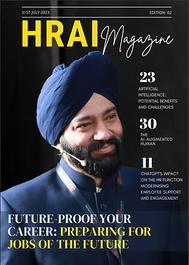
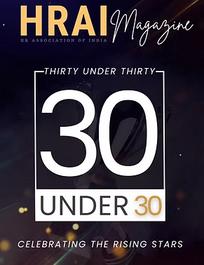



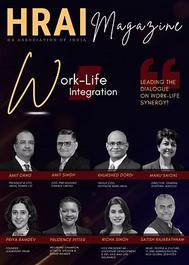


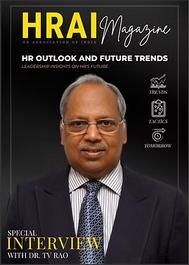
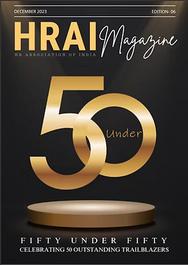

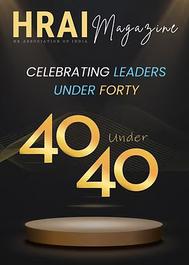


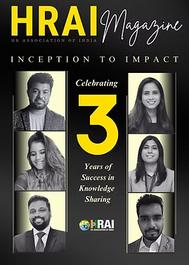
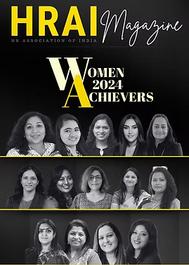
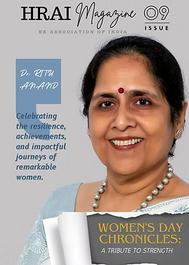
Premium Exposure: Our magazine boasts a wide readership comprising industry professionals, decision-makers, and trendsetters Your ad will gain exposure to a targeted and influential audience, maximizing your reach and impact
Compelling Content: Each issue of HRAI MAGAZINE is meticulously curated to offer captivating articles, insightful features, and thought-provoking interviews Your ad will be showcased alongside top-notch content, ensuring it receives the attention it deserves
Brand Credibility: Aligning your brand with our reputable publication will boost your company's credibility and reputation within your target market. It's a chance to reinforce your brand's authority and trustworthiness in front of a pool of professionals
Flexible Options: We understand that each company has unique advertising needs and budget considerations. That's why we offer a range of ad placement options to suit your preferences and requirements.
Multi-Platform Exposure: Beyond the E-Magazine edition, your ad will also be featured on our social media platforms, expanding your online visibility, and generating even more leads.
Exceptional Customer Support: Our dedicated team will work closely with you throughout the advertising process to ensure your campaign's success We value your satisfaction and strive to exceed your expectations
FOR MORE INFORMATION, CONTACT US AT: EMAIL: TEAM@HRASSOCIATIONOFINDIA.COM | CALL: +91 9096492621
COLLABORATE WITH HRAI






In today's rapidly evolving professional landscape, the conversation around Gender Equity and women in leadership continues to gain momentum. Yet, the discourse often centers on empowering women and what women need to do, when the focus should be on creating an environment conducive to their success. Women possess all the attributes necessary for leadership roles competence, resilience, creativity, and vision The real challenge lies in overcoming the systemic barriers that impede their progress. Let us explore the common hurdles women face in the workplace and discuss how to address them for a more equitable future.
Implicit Bias and Stereotypes- One of the most pervasive obstacles women encounter in their professional journeys is implicit bias and stereotypes. These biases often manifest in subtle ways, influencing hiring decisions, promotions, and evaluations Despite women having all the qualities needed for success, they are frequently underestimated or pigeonholed into roles that conform to traditional gender norms. For instance, women may be perceived as less assertive or less competent in leadership positions simply because of ingrained societal stereotypes.
To combat this, the organisations need to create systems, and multi-level inclusion checks within the processes and prioritize diversity training and awareness programs for managerial levels.
THE VALUE THAT WOMEN BRING TO BOARDROOMS IS UNPARALLELEDINCLUSIVE DECISION-MAKING, ENHANCED OVERALL CORPORATE GOVERNANCE AND FAIRNESS. THEIR UNIQUE SKILL, DIVERSE PERSPECTIVES, AND STRONG LEADERSHIP ABILITIES GO A LONG WAY IN CONTRIBUTING TO ORGANISATION’S GROWTH. EMPOWERMENT ISN’T JUST ABOUT OFFERING A SEAT IT’S ABOUT BUILDING A TABLE WHERE WOMEN ARE SPONSORED, SUPPORTED, AND TRUSTED TO LEAD. BECAUSE TRUE EQUITY AND PROGRESS BEGINS NOT WITH INVITATION, BUT WITH INTENTIONAL ACTION.


AI can assist in minimizing implicit bias in hiring and promotion processes. AI systems can help ensure that candidates are evaluated based on their skills and experience rather than subjective criteria leading to more equitable hiring and promotion practices.
Societal conditioning often dictates that women prioritize family responsibilities over their careers. This pressure can significantly limit their career progression, as many women find themselves choosing between professional aspirations and familial obligations. Achieving a perfect balance is a universal challenge, women often face the dilemma of balancing demanding careers with personal life obligations, which can impede their professional growth.
To address this issue, workplaces must offer flexible work arrangements and robust parental leave policies By normalizing shared family responsibilities and supporting working parents, organizations can alleviate the pressure women face to choose between career and family, allowing them to thrive in both areas AIdriven technologies such as AI-powered project management software and virtual collaboration platforms can enable women balance professional responsibilities with personal commitments, promoting work-life balance.
Mentorship and sponsorship are critical components of career advancement. Unfortunately, women often have less access to these opportunities compared to men. Mentors provide guidance and advice, while sponsors actively advocate for their protégés, opening doors to new
opportunities. The absence of these support systems can hinder women ' s professional growth and limit their exposure to essential networks.
To remedy this, companies should implement formal mentorship programs that actively pair women with leaders and mentors in their field. AI can enhance mentorship programs by using data to match women with suitable mentors and sponsors. AI-driven platforms can analyze profiles and past interactions to suggest mentor-mentee pairings that are likely to be fruitful, fostering stronger professional relationships and networks for women.
Another barrier women face is a lack of exposure to critical opportunities that are vital for career advancement Often, high-stakes projects and leadership roles are disproportionately offered to male employees, leaving women on the sidelines Elusive critical experience can stifle women ' s growth and prevent them from gaining the experience necessary to ascend to higher positions.
Organizations must strive to eliminate gender biases in project assignments and leadership opportunities By ensuring that women have equal access to challenging roles and critical projects, companies can foster an environment where women can showcase their capabilities and advance their careers
AI can offer personalized learning experiences through adaptive learning platforms. These platforms can identify skill gaps and recommend tailored training programs, enabling women to continuously develop their skills and remain competitive in their fields.


The gender pay gap remains a significant issue, with women earning less than their male counterparts for equivalent work. This disparity not only affects women ' s financial independence but also reflects broader systemic inequalities within the workplace. The pay gap can discourage women from pursuing higher-level positions and perpetuate the cycle of inequality
To address the gender, pay gap, organizations must commit to transparent salary practices and regular pay audits. AI can facilitate regular pay audits by analyzing compensation data to identify discrepancies in pay between genders By flagging these disparities, organizations can take corrective action to ensure that women receive equal pay for equal work
Conclusion- The organisations are victims to our conditioning and what we need is to shake that up and be ready to unlearn and learn, being open to our own blindspots and addressing them. It is not an easy path but what will help us succeed is a range of actions such as creating leadership accountability and ownership towards diversity, building the understanding that diversity contributes to organisation’s growth and success, strong diversity policies and development programs provide power and support women and their leadership journey, amplifying voices via Network and community and continuous education and sensitisation.
Adoption of AI holds significant potential to transform the workplace into a more equitable space As companies embrace AI-driven solutions. They not only pave the way for women ' s success but also cultivate
inclusive workplaces[S(1] , driving innovation and growth.
As we move forward, let us shift the narrative from empowering women to dismantling the barriers that prevent them from realizing their full potential. Creating an inclusive and equitable workplace is not merely a matter of ethics; it is a strategic imperative By setting the work environment right, we pave the way for a future where women ' s achievements are celebrated and their contributions are valued equally, ensuring that the workplace is a space where everyone can thrive
Shveta Verma is India & Asia Pacific Inclusion & Diversity Leader at PwC She has 23 years of work experience within Human Capital and across diversified industries Shveta joined PwC in March 2004 and her 19+ years of the journey have been outstanding. She started as a business HC partner for tax line of service, moved on to be the Human Capital Transformation leader for India, and now leads the Inclusion & Diversity function. In the last 8 years, her focus has been on the development and implementation of the Diversity Office & strategy, expanding the scope of Inclusion, People transformation strategy, work-life integration policies, enhancing the Employee experience and people value proposition, digitization & gamification of HC processes and leading Global teams & projects Optimism, being a fighter, integrity, influencing communication skills, questioning the status quo, leading from the front, leveraging the power of differences are some of the qualities and skills that Shveta possesses and infuses in her team Shveta is a triathlete, marathoner, fitness enthusiast and loves theatre She has won various awards for her acting skills during her college days. Her best way to beat the stress is learning the latest technology, music trends and working out with her 16-year-old son




In today’s rapidly evolving business world, empowering women in the workplace isn't just a matter of fairness it’s essential for long-term success. As women continue to make up a significant portion of the global workforce, creating an environment where they can thrive is not only the right thing to do, it is also a strategic advantage for businesses Studies have shown that diverse organizations and teams outperform their industry counterparts and peer groups, foster more creativity, and bring different perspectives to problem-solving.
Despite support systems, women still face numerous barriers in the workplace, including unconscious or conscious gender bias, underrepresentation in leadership roles, unequal pay and many a times, their own self limiting beliefs These in addition to the 3 Ms - Marriage, Maternity and Mobility challenges - where most often, due to social constructs, women’s careers end up being impacted the most, collectively slow them down
Empowering women means addressing these challenges head-on, enabling them to reach their full potential. It involves creating a supportive environment where they feel valued, have equal opportunities to grow, and can contribute their ideas without fear of discrimination. When women are given the tools, opportunities, and support to excel, the results are often transformative, enhancing team dynamics, business performance, and company culture

BY REMOVING BARRIERS, PROVIDING EQUAL OPPORTUNITIES, AND FOSTERING AN ENVIRONMENT OF SUPPORT AND INCLUSION, ORGANIZATIONS CAN UNLOCK THE FULL POTENTIAL OF THEIR WORKFORCE.


Some of the strategies for Empowering Women at workplace are,
·Mentorship: It is of utmost importance for women to have mentors and sponsors who can guide them, speak for them and champion their skills and abilities.
·Networking is another key skill that women need to develop.Studies have shown that ~80% of successful professionals consider this essential to their career success.
·Support Groups are essential communities that can be their strong support systems both at work and at home.
Inclusive Leadership: Organizations can encourage women to take on leadership roles through Targeted developmental plans, Future focused leadership pipelines’ Help to overcome self-limiting beliefs, Programs to eliminate bias
Ensuring meritorious and fair promotions
Equitable Policies & Initiatives that include flexibility in supporting women ’ s career growth
And, finally organization wide gender equality goals
Leadership commitment to this agenda will speak volumes for the culture of any organization.
At [24]7.ai ,our flagship gender diversity program is called Shakti, which denotes divine feminine energy and power and we believe aptly conveys the importance we assign to the power of diversity in the workplace.
The Shakti agenda and strategy rest on three key pillars – Hiring, Development, and Retention of Women
Hiring : Our commitment towards hiring for gender diversity has always been paramount through a multi pronged approach– partnerships with dedicated consultant partners, Women colleges and campus drives, Organizations and communities that exist to promote Women penetration in the workplace, Train and Hire programs, hiring from Tier2-3 cities and more
Development: Programs which help in the holistic growth of our women are modules and learning interventions like,
ASPIRE: for life and professional skills and overcoming self-limiting beliefs.
LEAP: Leadership Education and Advancement Program
WomEnable – our unique year long program to help build next generation women leaders , that has won multiple awards and been called out in our Great Place to Work Recognitions.
One on one focus groups discussions, Support groups, Art of Supervision workshop for new supervisors, Virtual Baby Showers, Virtual Summer Camps for kids, involving families in office engagement initiatives.
Shakti Speaks initiatives that drive retention conversations, inspiring journeys of internal, external and Client women leaders, discussions and open listening channels.
Focus on Wellbeing, safety and support- Free Company transport with security, PG assistance, Crèche tie-up for Returning Moms, special cabs for Expectant Moms.
Women friendly policies including wherever feasible, flexible working hours and choice of shift and work from


home models.
MaMate Program: Buddy and support groups for new and expectant mothers Equal Compensation Pay / Strict Pay Parity for similar roles Health and Safety for all and especially for women, both physical and mental through counseling support, talk shows and dialogues including family and spouses, to help manage the double burden of work and home.
Industry and media partnership and Recognitions - inspiring action internally and externally through exchange and spread of best practices- including at UN Women and UN India forums in India and overseas Education and action on Sexual harassment with a 20-member POSH Committee and policy A genderneutral POSH policy that applies to all. Breaking stereotypes and unconscious bias through regular interventions, certification programs and a Strong Code of Conduct framework for investigation and action in case of active demonstration of bias
Our Shakti EmpowHer Network, an extension of our existing Shakti Gender Diversity Program aims at empowering our women employees through various interventions and initiatives such as,
Allyship: Men and Women leaders mentoring women employees, especially at supervisory roles and above.
Women Leaders Network – All women leaders come together to discuss challenges, share best practices, collective solutioning and sharing personal journeys – Leaning in on each other as we know leadership can be
challenging at times and such connects reassure, give confidence and motivate them to continue to lead
Women’s Open Network – every woman in the organization gets together for a “ no agenda” connect once a quarter. This is aimed at bringing a sense of oneness in the community of women at [24]7.ai, to meet our woman leaders and interact, an opportunity for leaders to connect with our employees firsthand thereby creating a direct listening channel
Empowering women in the workplace is not just a moral obligation it’s a business imperative By removing barriers, providing equal opportunities, and fostering an environment of support and inclusion, organizations can unlock the full potential of their workforce. It is time now to #AcclerateAction by investing in women ’ s potential, creating a work culture that values equality, diversity, and empowerment
Susmita has over 3 decades of experience in People Function across HR, Sales & Profit Center management, Communication & Branding, Channel development, industry collaboration in IT Education & IT/ITES industries She is a recipient of numerous industry awards including 8 Asian Women in Leadership Summit 2019 She was featured in the Women Entrepreneur India magazine and recognized for leading People Practices for one of the Top 30 Companies for Women to Work For, 2021 Was awarded as Top HR Innovators in 2022, 50 Most Influential HR Leaders in 2024 and more. Through her career, she has been an active contributor in numerous external bodies & forums like State Govt nodal agencies, Universities, ICAI and ICWAI, Chambers of Commerce, and industry forums like CII, UN Women India and NASSCOM As HR Leader at [24]7 ai, she spearheaded some of the Best in Class and Award winning People Management initiatives, DEI & CSR practices, strategies and policies, to strengthen Organization Culture & support business growth & profitability An alumnus of XLRI Jamshedpur, she is also an active member of the Southeast Asia Leadership th



